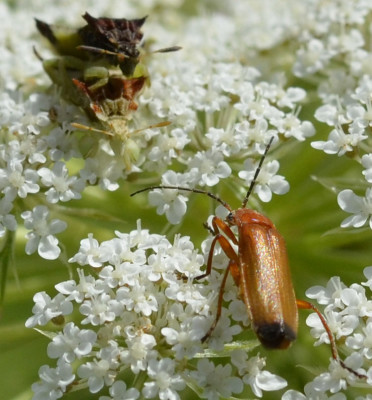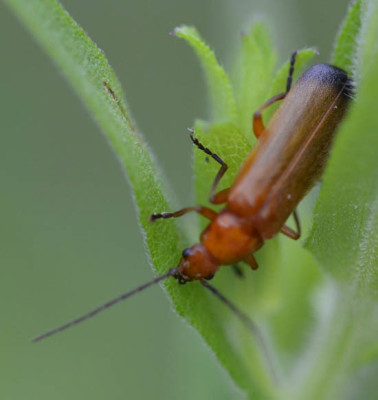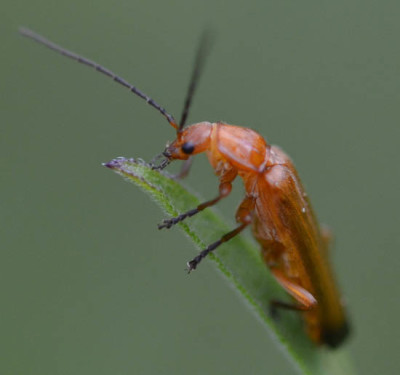This summer, I noticed a type of insect that was new to me walking around on top of the flowers in my back yard. Then I started noticing them all over the place: walking on goldenrod leaves, walking on Queen Anne’s Lace, even flying in an awkward buzzy way. I thought it would be something common but it wasn’t in my simple insect guides. So I went searching for the name of a fairly long, skinny beetle that was shiny red orange with a noticeable black colour at the tail end.
Firefly-ish but Not a Firefly
In shape, they look a bit like a firefly. The way they fly is also reminiscent of some fireflies. They don’t have any glow about them though.
Another noticeable thing about this insect is its long dark segmented antennae. The legs are also orange near the body and dark near the “feet.” They have fairly large black eyes.
I nosed around BugGuide.net but to my surprise no one had posted photos recently asking what these red orange insects were. I didn’t have a crisp photo so I didn’t want to post a question myself. Life got busy (and cloudy weather set in) and I put the problem aside for a week.
Eureka!
The next week, though, I was enjoying some photos on outdoorontario.net when suddenly I found the answer. Gary Yankech had posted an excellent photo of my mystery bug: and it was labeled “Common Red Soldier Beetle.”
Armed with this common name, a quick visit to BugGuide.net provided me with more details. To my satisfaction, I discovered these insects are part of the same group as Click and Firefly Beetles (Elateroidea) so the similarities were real.
Red Soldier Beetles March Atop Ontario Flowers after Invading from Europe
Apparently the red soldier beetles are a species introduced from Eurasia “some time ago” according to BugGuide. Although they do noticeably like to hang around on the heads of flowers they are not damaging the plants. These insects are predators. (I wonder if that’s why they have such large eyes?)

Both these Ambush Bugs and this Red Soldier Beetle are predators. I wonder if they just moved slowly back from each other or if….
Again, according to BugGuide.net, these soldier beetles eat insects that visit the flowers. The larvae stage eat “snails, slugs and ground-dwelling insects.” If that’s the case, the larvae should have a wonderful time in my yard. I have both snails and slugs in large numbers, unfortunately for my garden plants.
Related Reading
- Dragons Flying Around my Backyard near Toronto
- What Kind of Ladybug is Pink, Oval and has Large Black Spots on its “Head”?
Join In
Have you had Red Soldier Beetles patrolling in your yard? Please share your experiences with a comment.



Glad I came across this – just this week I have been noticing loads of these little red flying insects I’ve never seen before. All over my crops on the allotment so was a bit worried. Sounds like they are to be encouraged – I have tons of slugs & snails fro them to have a go at. Nice.
Yes, they seem to be having a boom year. I have some thistles I need to cut down at the edge of a garden (but the goldfinches love them) and this year they’ve been hosting many of these insects.
Was doing some weeding today, July 10, 2015 and these soldier beetles were all over my thyme flowers. I live in Center Quebec in a farming community so bugs are normal. I’m learning all the time about different bugs and wether they are beneficial or not. There was a time before internet when I ‘d get out my bug spray and spray them all. Today, I check first and am happy to be able to see that the majority are good bugs. The pictures are wonderfully detailed….love it!
I’m glad you didn’t have to waste spray on a non-harmful insect. I hope your thyme crop thrives!
Thanks! I was wondering what that insect was.
I guess you have seen some too!
I thought it was not a soldier beetle but it was
There sure are a lot of insects to sort through!
Huge numbers 100s or more on 6ft x 6ft shrub/thistle in fabulous herbaceous border in Winpole Hall Farm near Royston UK. I will try to post images with Ringlet butterflies which I was photographing at the time.
Luckily they aren’t damaging to the plants. I’m glad you got a chance to see them both up close!